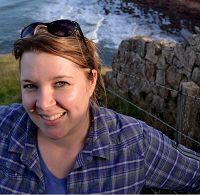Critical Zone Profile - JORDEN HAYES (geophysicist, Assistant Professor)
Jorden is a geophysicist and currently an Assistant Professor at Dickinson College in Carlisle, Pennsylvania. She completed her PhD in geophysics at the University of Wyoming in 2016 and B.S. in Geology at Olivet Nazarene University in 2007. Jorden is broadly interested in the application of seismic methods to inform the understanding of Earth processes. This broad interest has led to many diverse experiences ranging from marine research cruises in the Pacific to field campaigns in the mountains of the western U.S. Most recently, Jorden has focused her interests towards near-surface processes, including chemical and physical weathering and landscape evolution.
"There are still many unanswered questions relating to how rock in the deep critical zone is transformed into a habitable substrate for life at the surface." - Jorden Hayes
Jorden and Brad Carr (WyCEHG) in front of a geoprobe that collects push core samples of the weathered rock in the subsurface. Geoprobe owned by the Wyoming Center for Environmental Hydrology and Geophysics.
The goal of my work is to characterize the structure of the deep critical zone at the landscape scale to better understand the processes that drive variations in that structure. By relating geophysical measurements taken along the surface to high-resolution subsurface properties from physical samples, those measurements can be extrapolated at the landscape scale. We can identify broad patterns and trends therein, where those patterns are clues to the processes that generated them.
The deep critical zone is an important reservoir for water and nutrients. As rock weathers and erodes those key substances can be accessed by life. If we are to better predict how the deep critical zone will respond to changing climates, we must first understand what processes dominate (e.g., chemical or physical) and how those processes are affected by parameters such as the presence of roots and rock type.
This work is applicable to many disciplines in the scientific community. It has shown that physical processes that cause volumetric expansion of rock in the deep subsurface can dominate over chemical processes in the generation of porosity. Porosity is important to hydrology because the opening of pore space allows for groundwater storage and flow. In this way, porosity generation regulates the pathways that plants use to access water and therefore, important for ecology and biology. The next step in this research will be to tease out the relative importance of processes that could be responsible for this physical expansion of rock.
Critical Zone Observatories (CZOs) help improve our management of natural resources by allowing policy makers and the general public to make more informed decisions. If we can better quantify how much water is stored in the subsurface and where those reservoirs are, then perhaps we can develop more sustainable plans to utilize that resource.
Jorden looking at resistivity data from a collaborator inside a “cave” at the University of Wyoming that allows them to look at a dataset in 3-dimensions.
In many ways our Earth is changing at rates unprecedented in human history and it is now more important than ever to know what will happen in the future. Critical zone science addresses key questions important to life on our planet: How is life responding to natural and anthropogenic forces? and how will it respond in the future?
The CZO network has been invaluable to my work because this community is full of rigorous interdisciplinary scientists who are willing to collaborate, help encourage new ideas, and offer constructive feedback.. I cannot emphasize enough how important the interdisciplinary aspect of critical zone science has been in my research. Tackling a complex scientific question with someone outside of my discipline of geophysics almost always results in new insights. For example, discussions with geochemists, ecologists, and botanists offered me a whole new perspective on the role biota might play in generating porosity in the deep critical zone.
Jorden Hayes, Geophysicist
Jorden and Brad Carr (WyCEHG) in front of a geoprobe that collects push core samples of the weathered rock in the subsurface. Geoprobe owned by the Wyoming Center for Environmental Hydrology and Geophysics.
Jorden looking at resistivity data from a collaborator inside a “cave” at the University of Wyoming that allows them to look at a dataset in 3-dimensions.
Related News

Critical Zone Profiles - Meet the people doing CZO science (Early-Career)
23 Mar 2016 - Get a sense of the people and the work. Several early-career scientists that were students at one of the CZOs are profiled here.

Critical Zone Profiles - Meet the people doing CZO science (Southern Sierra CZO)
07 Sep 2015 - Get a sense of the people and the work. Several members of the Southern Sierra CZO are profiled here, including students and professors.
Explore Further






